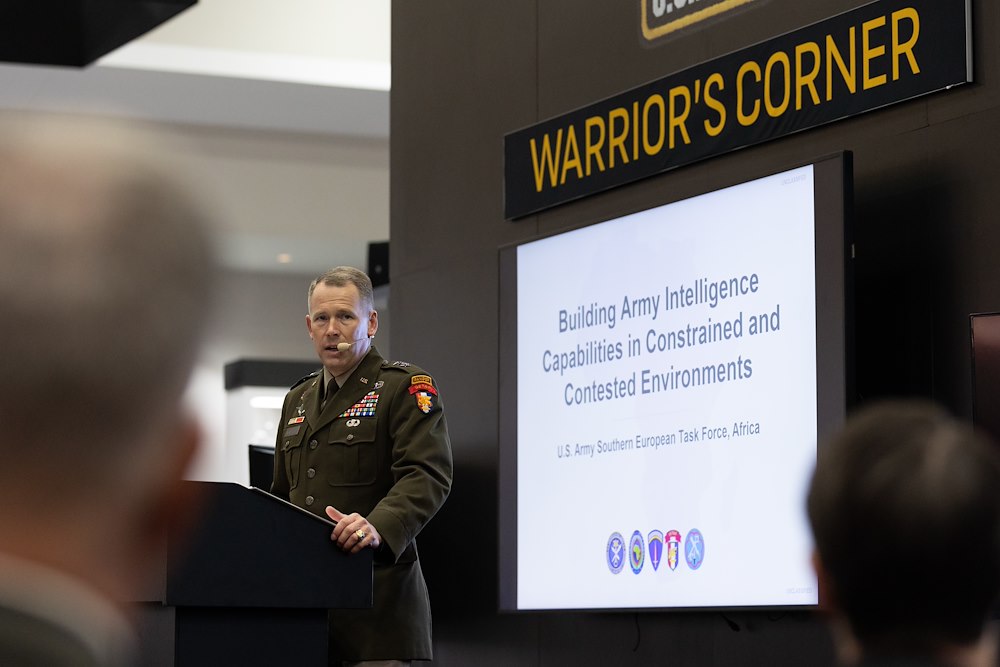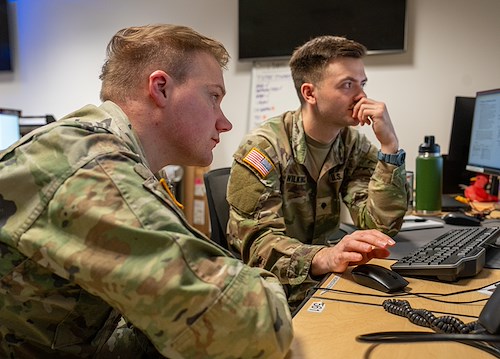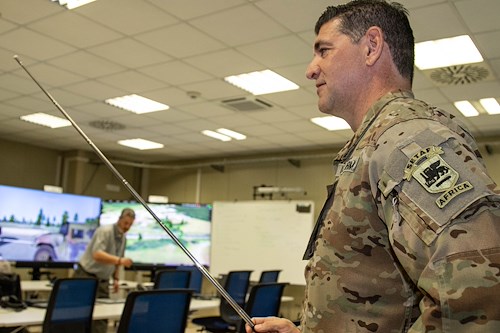Gallery contains 3 images
×
Photo 1 of 3
207th MIB takes on Army data modernization plan
Maj. Gen. Todd R. Wasmund, Commanding General, U.S. Army Southern European Task Force, Africa (SETAF-AF), opens the U.S. Army Warriors Corner presentation, “Building Army Intelligence Capabilities in Constrained and Contested Environments” at the Association of the United States Army Annual Meeting & Exposition, held in Washington D.C., 11 October, 2022. Maj. Gen. Wasmund and Col. Mark A. Denton addressed Africa’s highly constrained intelligence collection-contested environment and how the 207th Military Intelligence Brigade (Theater) pilot program, the Africa Data Science Center, enables intelligence warfighters through innovation, collaboration, and data-first thinking.
Photo 2 of 3
207th MIB takes on Army data modernization plan
Col. Mark A. Denton, Commander, 207th Military Intelligence Brigade (Theater), speaks at the U.S. Army Warriors Corner presentation, “Building Army Intelligence Capabilities in Constrained and Contested Environments” during the Association of the United States Army Annual Meeting & Exposition on 11 October, 2022. Maj. Gen. Wasmund and Col. Mark A. Denton addressed Africa’s highly constrained intelligence collection-contested environment and how the 207th Military Intelligence Brigade (Theater) pilot program, the Africa Data Science Center, enables intelligence warfighters through innovation, collaboration, and data-first thinking.
Photo 3 of 3
207th MIB takes on Army data modernization plan
Maj. Gen. Todd R. Wasmund, Commanding General, U.S. Army Southern European Task Force, Africa (SETAF-AF), and Col. Mark A. Denton, Commander, 207th Military Intelligence Brigade (Theater), answer questions after the U.S. Army Warriors Corner presentation, “Building Army Intelligence Capabilities in Constrained and Contested Environments” at the Association of the United States Army Annual Meeting & Exposition held in Washington D.C., 11 October, 2022. (Courtesy photo)
Vicenza, Italy — A small team of contractors south of the Alps is providing assistance in answering U.S. Army Southern European Task Force, Africa (SETAF-AF), U.S. Army Europe and Africa, and U.S Africa Command’s intelligence requirements with the power of data science.
Since 2018 the Africa Data Science Center, organized under the 207th Military Intelligence Brigade-Theater, enables intelligence warfighters through innovation, collaboration and data-first thinking. Their efforts were recently highlighted at this year’s Association of the United States Army’s Annual Meeting and Exposition, held in Washington D.C. The Africa Data Science Center, or the ADSC, is a U.S Army Intelligence and Security Command (INSCOM) pilot program and a part of the Army’s data modernization plan. Staffed by only two data scientists, one data engineer, and an officer-in-charge, this small office makes an outsized impact by combating information overload and bridging intelligence gaps.
The team automates and improves existing analytical and business workflows, integrating data science into the intelligence process.This automation streamlines the ability of military intelligence analysts to process and exploit more data, in turn providing decision makers with answers at a much quicker pace.
Many intelligence analysts are faced with an overload of information - without the time to process it all manually. Lt. Col. Christian Gregoire, commander of the 522nd Military Intelligence Battalion, 207th Military Intelligence Brigade-Theater’s Operations Battalion, knows first hand the information overload that his analysts experience.
“They receive information from a variety of different sources, as well as what is publicly available, this can be overwhelming. This is the point where the ADSC provides an advantage. The team assists the analysts by focusing them on the relevant data which will facilitate research and analysis.”
These faster products are possible with the working partnership of the data scientists and the intelligence analysts. In certain situations, an analyst may have an overwhelming amount of information, which does not allow them to detect a pattern or trend, but the partnership with the data scientist alleviates that. The scientist, with the use of machine-enabled insights, is able to narrow the grid search which permits analysts to be more efficient and effective.
Warrant Officer Christopher Poles, ADSC's officer in charge, who manages the small team of contractors, has noted that this partnership also allows for an exchange of knowledge between the data scientist and the analysts. “With them sitting side by side you can see constant learning on both sides. As the scientist learns more of what the analyst does and vice versa, the support to help the analyst increases, to include the improvement in production and analysis,” said Poles.
The scientists teach analysts the best methodologies, capabilities, and tools of data science, optimizing the intelligence process.
In the years to come, the ADSC seeks to create products and workflows that support intelligence warfighting and continue to build data science solutions to modernize the Army intelligence and security enterprise.
“Data science is the future when it comes to an additional support system not only for intelligence but for the Army as a whole. Being in the information age, data science has already made a mark in big business, and now you will begin to see it in all branches of the military. This is the answer to information overload,” said Poles.














